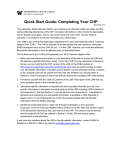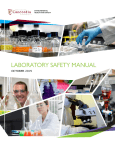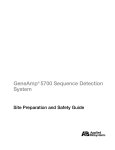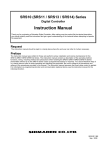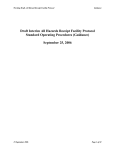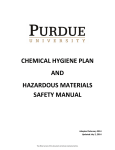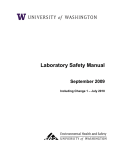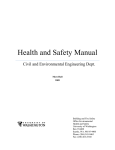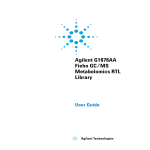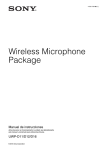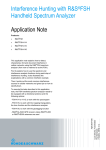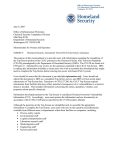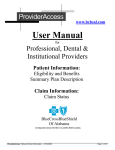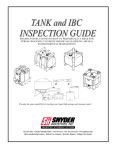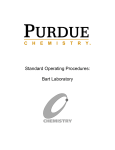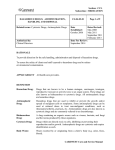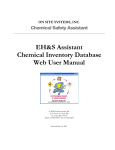Download Section 2.C of the Laboratory Safety Manual
Transcript
Laboratory Safety Manual Page 2-1 September 2015 Section 2 - Chemical Management Section 2 - Chemical Management Contents A. BASIC LABORATORY SAFETY PRACTICES ............................................ 2-3 1. 2. 3. 4. 5. 6. 7. 8. Working Alone ................................................................................. 2-3 Prevent Chemical Exposure ............................................................ 2-3 Washing Hands ............................................................................... 2-4 Food and Drink ................................................................................ 2-4 a. Glassware/Utensils ...................................................... 2-4 b. Storage of Food/Beverages ......................................... 2-4 Vacuum............................................................................................ 2-4 Access to Emergency Exits and Equipment .................................... 2-4 Laboratory Signs .............................................................................. 2-4 Housekeeping .................................................................................. 2-5 B. CHEMICAL INVENTORY AND MSDSs/SDSs ............................................ 2-5 1. Access to MyChem .......................................................................... 2-5 2. Conducting your Chemical Inventory ............................................... 2-6 3. Safety Data Sheet/Material Safety Data Sheet (SDS/MSDS).......... 2-6 C. CHEMICAL PROCUREMENT ..................................................................... 2-7 1. 2. 3. 4. 5. 6. 7. 8. Hazardous Chemicals...................................................................... 2-7 Pharmaceuticals .............................................................................. 2-7 DEA Controlled Substances ............................................................ 2-7 Non-Denatured Ethyl Alcohol........................................................... 2-8 Radioactive Materials ...................................................................... 2-8 Highly Dangerous Materials ............................................................. 2-8 Compressed Gas Cylinder Procurement ......................................... 2-8 Chemical Exchange ......................................................................... 2-8 D. CHEMICAL STORAGE ............................................................................... 2-9 1. Evaluate Chemical Hazards for Storage.......................................... 2-9 a. Flammability ................................................................. 2-9 b. Reactivity ...................................................................... 2-9 c. Corrosivity .................................................................... 2-9 d. Toxicity ......................................................................... 2-9 2. Chemical Storage Practices ............................................................ 2-9 3. Chemical Storage Quantity Limits ................................................. 2-11 a. Control Zones ............................................................. 2-11 b. Flammable Liquids in Basements .............................. 2-12 Page 2-2 September 2015 Section 2 – Chemical Management c. Laboratory Safety Manual Additional Requirements ............................................ 2-12 E. CHEMICAL LABELING ............................................................................ 2-13 1. Original Container .......................................................................... 2-13 2. Labeling Stock/Working Solutions ................................................. 2-14 a. Labeling Specialized Containers ................................ 2-14 b. Additional Label Required for Peroxide-Forming Chemicals 2-14 c. Additional Label Required for CFATS Chemicals ...... 2-15 d. Labeling Waste Containers ........................................ 2-15 F. TRANSPORTING CHEMICALS ............................................................... 2-15 1. Transporting between Floors and Buildings on Campus ............... 2-15 a. Moving a Single Chemical .......................................... 2-15 b. Moving Multiple Chemicals......................................... 2-16 2. Transporting Chemicals off Campus ............................................. 2-16 a. Vehicle Use ................................................................ 2-16 b. Shipment by Others.................................................... 2-16 c. Training ...................................................................... 2-17 d. Laboratory Moves ....................................................... 2-17 G. SPECIAL CHEMICAL HAZARDS ............................................................. 2-17 1. Reactive Chemicals ....................................................................... 2-17 a. Compounds That Generate Toxic Gases .................. 2-17 b. Oxidizers .................................................................... 2-18 c. Chemicals That May Polymerize ................................ 2-18 d. Pyrophoric Chemicals ................................................ 2-19 e. Water Reactive Chemicals ......................................... 2-19 2. Potentially Explosive Chemicals .................................................... 2-19 a. Nitrated Compounds .................................................. 2-20 b. Organic Peroxide-Forming Solvents .......................... 2-20 c. Azides ......................................................................... 2-22 d. Fulminates .................................................................. 2-22 3. Highly Toxic Substances ............................................................... 2-22 a. Precautions for Use .................................................... 2-22 b. Categories of Highly Toxic Chemicals ....................... 2-23 4. Carcinogens and Reproductive Hazards ....................................... 2-23 5. Hazardous Drugs ........................................................................... 2-23 6. Sensitizing or Allergenic Chemicals ............................................... 2-24 7. Synthesized Chemicals.................................................................. 2-24 a. Nanoparticles ............................................................. 2-24 b. Providing Synthesized Chemicals to Others .............. 2-24 8. Compressed Gases, Gas Cylinders and Liquid Cryogen Containers2-25 a. Hazards of Compressed Gases ................................. 2-25 b. Safe Practices ............................................................ 2-25 c. Moving Compressed Gas Cylinders ........................... 2-27 d. Leaking Gas Cylinders ............................................... 2-27 e. Compressed Gas Piping and Tubing ......................... 2-27 9. Flammable and Combustible Liquids ............................................ 2-28 Page 2-3 September 2015 Section 2 - Chemical Management Laboratory Safety Manual a. Vapor Control ............................................................. 2-28 b. Ignition Source Control ............................................... 2-29 c. Grounding Concerns .................................................. 2-29 10. Homeland Security Chemicals of Interest ..................................... 2-30 a. Do Not Ship List ......................................................... 2-30 b. Do Not Ship Labels .................................................... 2-31 c. Disposing of Chemicals on the Do Not Ship List........ 2-31 11. Process Safety for Highly Hazardous Chemicals .......................... 2-31 Tables Table 2-1 Table 2-2 Table 2-3 Table 2-4 Table 2-5 Table 2-6 Table 2-7 Table 2-8 Table 2-9 Table 2-10 Table 2-11 Table 2-12 Chemical Storage Recommendations .................................... 2-11 Approved Flammable Liquid Storage Containers ................... 2-12 Toxic Gas Generators ............................................................ 2-18 Oxidizers ................................................................................. 2-18 Chemicals that May Polymerize ............................................. 2-18 Pyrophoric Chemicals............................................................. 2-19 Water Reactive Chemicals ..................................................... 2-19 Nitrated Compounds .............................................................. 2-20 Peroxide-Forming Chemicals ................................................. 2-22 Sensitizing or Allergenic Chemicals ....................................... 2-24 Flash Points and Flammability Limits of Some Chemicals ..... 2-28 Reportable if Shipped Chemical List ...................................... 2-30 Figures Figure 2-1 Figure 2-2 Figure 2-3 Figure 2-4 Figure 2-5 A. Example of Original Label ..................................................... 2-13 Peroxide Label (UoW 1716) .................................................. 2-14 Do Not Ship Label ................................................................. 2-15 Peroxide Label (UoW 1716) .................................................. 2-21 Do Not Ship Label ................................................................. 2-31 BASIC LABORATORY SAFETY PRACTICES 1. Working Alone Do not work alone in the laboratory if the procedures conducted involve highly hazardous substances or processes (such as those described in section G later in this section). If you are working alone with lesser hazard chemicals, let personnel in other laboratories know of your presence or develop an accountability system with your supervisor or co-workers. 2. Prevent Chemical Exposure Prevent skin contact with chemicals. For example, use appropriate personal protective equipment (PPE) (goggles, gloves, and/or lab coat per Lab Safety Manual Section 5.B) but consider it as “the last line of defense” and use other precautions, such as using appropriate containment equipment and checking regularly that connections are tight. Clean up spills as soon as possible and minimize clutter at workspaces to avoid inadvertent exposure. Prevent inhalation of chemicals. For example, use a fume hood whenever handling volatile or aerosolized chemicals, even if they are of relatively low toxicity. Cap chemicals as soon as is possible. Limit the smelling of chemicals to the minimum amount necessary; only smell a chemical if no other method of identifying a chemical is available and just waft the air at the Page 2-4 September 2015 Section 2 – Chemical Management Laboratory Safety Manual container opening towards your nose. Investigate the source of unfamiliar odors in order to eliminate them. Prevent ingestion of chemicals. For example, do not taste chemicals. Mouth suction must not be used to pipet chemicals or to start a siphon; instead, a pipet bulb or an aspirator must be used to provide suction. Prevent injection of chemicals. For example, dispose of needles as soon as the injection is complete. Use needles with inherent safety devices that prevent inadvertent needle sticks. Dispose of sharps into appropriate waste containers and do not over-fill sharps containers. If operating a high-pressure system, never check for a pressure leak using your hands. 3. Washing Hands Wash hands well with soap and water after removing gloves and before leaving the laboratory area. Never wash with organic solvents. (See Section 5.B Personal Protective Equipment and Appendix G Gloves for more information.) 4. Food and Drink Food and drink consumption in the laboratory increase the chance of exposure to chemicals; consumables are prohibited from being stored, prepared, or consumed in laboratories that use chemicals. a. Glassware/Utensils Glassware or utensils that have been used for laboratory operations must never be used to prepare or consume food or beverages. b. Storage of Food/Beverages Laboratory refrigerators, ice chests, and cold rooms must not be used for food or beverage storage. 5. Vacuum Use extra care when evacuating air from glassware. Shield or wrap the glassware to contain chemicals and glass fragments should implosion occur. When possible use thick wall vacuum glassware. 6. Access to Emergency Exits and Equipment Storage, even temporary storage, and equipment must not block doorways, corridors, aisles, and stairways, to assure unobstructed access to exits in the event of an emergency. Likewise, emergency equipment, such as eyewashes, deluge showers, fire extinguishers, and fire alarm pull stations, must be directly accessible. 7. Laboratory Signs Laboratory signs must be posted as described in Section 4.C. These signs may provide information (e.g., emergency numbers), prohibit unsafe behavior or require protective measures, or designate locations of various supplies and equipment. Magnetic or framed signs that can be easily moved may be used to designate a temporary hazard. Warning signs must be removed when the hazard no longer exists, such as a sign indicating the presence of a chemical that is no longer kept in a laboratory. Laboratory Safety Manual 8. Page 2-5 September 2015 Section 2 - Chemical Management Housekeeping Laboratory bench tops and other work surfaces must be provide enough space to safely carry out procedures. Aisles and egress routes must be clear to allow for prompt evacuation in the event of a spill, fire or other emergency. Maintain the following in the laboratory at all times: Flammable materials are kept away from ignition sources. Incompatible materials are separated . Emergency equipment and supplies (eyewash, shower, spill kit, and fire extinguisher) are readily accessible. Fume hoods are kept uncluttered. Shelves, cabinetry, refrigerators and other storage equipment must be orderly and all chemicals and chemical waste properly labeled. Label information should be visible (including compressed gases). Storage on the floor should be limited, temporary in nature, and in accordance with this Safety Manual. Sinks should be typically clear of dirty glassware. Surfaces must be promptly cleaned if contaminated with hazardous materials and periodically cleaned as needed. Garbage, recyclables, and surplus equipment and materials must be removed regularly. Pneumatic and gas tubing, power, control and data wiring, must be routed so they are protected from physical damage, do not create a tripping hazard, and are adequately secured to appropriate infrastructure. B. CHEMICAL INVENTORY AND MSDSs/SDSs Laboratories must maintain chemical inventories in MyChem, the University of Washington’s campus-wide chemical tracking system. MyChem is designed for use during emergency planning efforts and to help laboratories comply with federal, state, and local regulations. Chemical inventories, location contacts, and chemical specific hazard summaries are provided to emergency personnel so they know what chemicals may be involved in an accident and who to contact in the event of an emergency. Laboratories should use these chemical inventories to keep track of chemicals to avoid unnecessary purchases and to avoid leaving old or unneeded chemicals in storage. Laboratory staff are required to maintain up to date chemical inventories in MyChem to facilitate compliance with Bothell, Seattle or Tacoma Fire Department Hazardous Material Storage and Use Permits (occupancy permits), EPA Community Right-To-Know reporting, and Department of Homeland Security chemical security requirements. MyChem stores approximately 500,000 hazard summaries in the form of Material Safety Data Sheets (MSDSs) or Safety Data Sheets (SDSs). As the inventory is entered, the MSDS/SDS is attached and readily accessible. All employees should be able to readily access an MSDS/SDS for any chemical they are using. 1. Access to MyChem For access to MSDS/SDSs, go to http://mychem.ehs.washington.edu and login using your UWNetID and password. To request access to site-specific chemical inventories and the Chemical Exchange, send an email to [email protected] . Page 2-6 September 2015 Section 2 – Chemical Management Laboratory Safety Manual MyChem is easy to use, but if you have questions or desire additional information, a MyChem User’s Manual is available on the MyChem web site (http://mychem.ehs.washington.edu). You may also phone EH&S at 206-616-4046. Hands-on computer training is available for groups upon request. Contact EH&S at [email protected] or call 206-543-7201. 2. Conducting your Chemical Inventory Personnel must inventory all chemicals found in the laboratory and specify the maximum amount normally found at this location. Dilutions and reagents prepared in the lab for further work do not need to be added to the inventory, but must have a container label applied unless the preparation will be all used or disposed that day. Review and update inventories annually and whenever there are significant changes in your chemical inventory, such as when you are moving a laboratory or starting a new project. The “MyChem User Guide” contains an inventory worksheet to aid the inventory process. To view the “MyChem User Guide” log into MyChem (http://mychem.ehs.washington.edu ) and select the “User Guide” from the menu options. While conducting your inventory, examine containers for deterioration and integrity. Chemicals that are expired, in bad shape or no longer needed must be managed as hazardous chemical waste. For more information about chemical waste management, see Section 3 of this manual. After completing the inventory, the Chemical Hygiene Officer should print two copies of the inventory from MyChem: one copy for the lab and one for home in case of an after-hours emergency in the laboratory. 3. Safety Data Sheet/Material Safety Data Sheet (SDS/MSDS) Safety Data Sheets (SDSs) and Material Safety Data Sheets (MSDSs) are documents that describe the physical and health hazards of chemicals. Manufacturers of chemicals must provide SDSs/MSDSs for chemicals that they sell. Recent changes in the regulation require the manufacturers begin replacing MSDSs with the new SDS format. As a result EH&S will begin replacing the online MSDS with the SDS as we receive them. Although many SDSs/MSDSs have limited application in laboratories due to their orientation towards industrial use of large quantities of a chemical, they provide basic information that all persons using that chemical need to know. MyChem is the University of Washington’s centralized SDS/MSDS database for chemicals used by University personnel (see Section B.1, above). EH&S maintains the MyChem SDS/MSDS database. Laboratory staff and students must have ready access to SDSs/MSDSs for all chemicals used in the laboratory. The department or laboratory may choose whether to maintain the SDSs/MSDSs in either electronic or paper format. The source of the SDS/MSDS is less important than the requirement that all personnel using chemicals or working around the chemicals must be able to demonstrate that they can retrieve the SDS/MSDS for a chemical within a short period (such as within five minutes). MyChem allows researchers to link to electronic SDSs/MSDSs directly, so is a suitable tool for fulfilling this requirement. EH&S recommends laboratories maintain paper copies of SDSs/MSDSs for the hazardous chemicals most likely to spill and/or cause injury to someone. Having an SDS/MSDS immediately available when someone has been exposed to a hazardous chemical helps emergency personnel decide how to respond and treat that person. Call EH&S at 206-616-3441 to request assistance locating or accessing MSDSs/SDSs during business hours. If the SDS/MSDS is online in the MyChem system, EH&S will email or fax a copy within a work shift. Chemicals that do not have an SDS/MSDS in the system will take Laboratory Safety Manual Page 2-7 September 2015 Section 2 - Chemical Management longer to research and obtain. After business hours, contact the UWPD at 206-685-8973; UWPD will contact an EH&S representative. If an SDS/MSDS is received with a chemical shipment please maintain a copy in the lab, and send the original to EH&S (Box 354110, c/o SDS/MSDS Coordinator) for addition to the MyChem database. C. CHEMICAL PROCUREMENT Most chemical products can be purchased without restriction from suppliers through eProcurement (on-line ordering system) or through UW Purchasing Services. However, the following rules and guidelines apply to some chemicals. 1. Hazardous Chemicals Order only the amount of chemicals needed. Many manufacturers will supply smaller quantities or containers if requested by the purchaser. Do not stockpile chemicals. Chemicals that are expired and/or appear to be no longer useful are considered hazardous waste. Purchase hazardous chemicals in plastic coated bottles (when available) instead of uncoated glass bottles. If possible, hazardous chemicals should be received directly by the laboratory. If it is received in an office, there should be a safe location such as a designated table with adequate open space reserved for temporary storage of the package. When you open a shipment, you should verify that the proper chemical was sent, that the container is intact, and that the label is legible. The date of receipt should be written on the container’s label. 2. Pharmaceuticals Pharmaceuticals not regulated by the Drug Enforcement Administration (DEA), e.g. antibiotics, heparin, sterile water, and over the counter drugs, can be purchased through UW Medicine Drug Services. Some restrictions may apply. For more information and to see the pharmacy formulary list, go to https://depts.washington.edu/drugsvcs . If you do not know exactly what is needed, email questions to [email protected]. 3. DEA Controlled Substances DEA registrants can procure controlled substances from a drug company, wholesaler or UW Medicine Drug Services. If you wish to order a controlled substance through Drug Services, a current Controlled Substances Registration Certificate must be faxed or mailed to Drug Services before an order can be filled. Controlled substances must be stored in a locked cabinet with limited access. A perpetual inventory must be maintained and the inventory forms used must meet DEA and State regulations. Expired or waste (undesired) drug(s) must be kept secure in a locked cabinet in a separate container properly labeled for content, and inventoried until disposal. Drug Services will provide the contact information of DEA-licensed reverse distributors who must be used for disposal. For more information on procurement or DEA-licensed reverse distributors, contact Drug Services ([email protected]). Page 2-8 September 2015 Section 2 – Chemical Management 4. Laboratory Safety Manual Non-Denatured Ethyl Alcohol Instructions for obtaining approval and purchasing non-denatured ethyl alcohol are detailed on the UW Procurement web site at https://f2.washington.edu/fm/ps/buying/alcohol . Instructions for maintaining accountability for tax-free ethyl alcohol are in Administrative Policy Statement (APS) 15.1 at http://www.washington.edu/admin/rules/APS/15.01.html. 5. Radioactive Materials The State of Washington Department of Health, Division of Radiation Protection, licenses radioactive materials use. Using radioactive materials requires the prior approval of EH&S. Orders for radioactive materials must be placed through the UW Purchasing Department. 6. Highly Dangerous Materials Materials that are extremely hazardous to property, health or the environment (explosives, pyrophoric materials, highly water reactive chemicals, and highly toxic gases, for example) must not be procured until the necessary administrative, engineering and environmental controls are in place. Hazardous materials must be stored and used in accordance with numerous regulations including, but not limited to, the International Fire Code and local amendments. See Section G: Special Chemical Hazards, below, for examples. Contact EH&S at 206-543-0465 for more information. 7. Compressed Gas Cylinder Procurement Only order the amount of gas that you need. Some gas suppliers will not take returns of partially full or empty cylinders or containers. Whenever possible gas cylinders should be purchased through the preferred supplier, Praxair, to ensure that the supplier has a cylinder return authorization program. Please refer to the UW eProcurement web site http://www.washington.edu/admin/stores/eprocurement and specifically at https://www.washington.edu/admin/purchstores/home_commodity/comp_gases.html . Additional information is available on the EH&S web page http://www.ehs.washington.edu/fsohazmat/gascylinders.shtm . If a different vendor must be used to provide a specialty gas, the purchaser must get a written return agreement from the distributor or manufacturer prior to purchasing the gas. It is important that the return agreement include a statement requiring the manufacturer to take back both the cylinder and any unused gas. The purchaser should retain this agreement until the manufacturer has accepted the returned cylinder. 8. Chemical Exchange The UW Chemical Exchange program facilitates the free exchange of chemicals campus-wide via MyChem, the online chemical inventory system. Consider checking the online Chemical Exchange (accessible only to UW employees) for chemicals before you buy new chemicals. For more information about this program, see the MyChem website at http://www.ehs.washington.edu/epomychem/index.shtm. Laboratory Safety Manual Page 2-9 September 2015 Section 2 - Chemical Management D. CHEMICAL STORAGE 1. Evaluate Chemical Hazards for Storage The hazards due to the reactions between incompatible chemicals are many: Generation of heat. Fire. Explosion. Toxic gas or vapor production. Flammable gas or vapor production. Formation of a substance with greater toxicity than the reactants. Formation of shock or friction-sensitive compounds. Pressurization of closed vessels. Solubilization of toxic substances. Dispersal of toxic dusts and mists. Violent polymerization. The general approach is to separate all chemicals into compatible groups. The specific Safety Data Sheet (SDS) or Material SDS should always be consulted when evaluating chemical properties and hazards of the materials for storage. Most chemicals have multiple hazards; decisions should be prioritized as follows: a. Flammability The first (number one) consideration for storage is the flammability characteristic of the material. If the chemical is flammable, it should be stored in a flammable cabinet. (If the total for flammables exceeds the quantity limits in paragraph 2.D.3 below, they must be stored in a flammables cabinet.) b. Reactivity If the material will contribute significantly to a fire (e.g., oxidizers), it should be isolated from flammables. If the material will contribute significantly to a fire when water is applied (e.g., water-reactive chemicals), it should be stored to ensure it is protected from any contact with water, including water that would be applied while extinguishing a fire in the lab. Isolate materials that can react with themselves (polymerization, for example). Isolate explosives. c. Corrosivity Review the corrosivity of the material and store accordingly. d. Toxicity Finally, review the toxicity of the material, with particular attention paid to regulated materials (this may mean that certain chemicals will be isolated within a storage area). For example, an extreme poison that is also flammable should be locked inside the flammable storage cabinet. 2. Chemical Storage Practices Establish and follow safe chemical storage and segregation procedures for your laboratory. Ideally, practices will include: Page 2-10 September 2015 Section 2 – Chemical Management Laboratory Safety Manual Provide an appropriate storage place following guidelines in Table 2-1 for each chemical and return the chemical to that location after use; Incompatibles must not be stored together; refer to http://www.ehs.washington.edu/fsosurveys/chemcompat.shtm, the Chemical Compatibility Chart; Store in compatible containers, and use compatible tubing and reaction vessels; Avoid storing chemicals on bench tops, except for those chemicals being currently used; Avoid storing chemicals in laboratory hoods, except for those chemicals being used currently; Store volatile toxics and odoriferous chemicals in a ventilated cabinet, if available; Do not expose stored chemicals to heat or direct sunlight; Store heavy bottles on lower shelves; Store corrosives below eye level; Containers of chemicals must be capped when not in use; make sure that caps on containers are secure; replace damaged caps; If a chemical does not require a ventilate cabinet, store it inside a closable cabinet or on a shelf that is anchored and that has a lip to prevent containers from sliding off; Chemicals (except cleaners) should not be stored under the sink, near the sink or in the sink, to minimize the chance of accidents and improper discharges to the sanitary sewer; Do not store chemicals in hallways, corridors or exit ways; Use secondary containment to prevent incompatible chemicals from mixing and reacting with each other if they must be stored adjacent to each other on a benchtop; Use secondary containment or spill control (such as placing the container on an absorbent pad) is generally required for containers on the floor; Particularly hazardous substances (highly dangerous or toxic chemicals, select carcinogens, mutagens, and teratogens) should be stored together if compatible. Signs should be posted indicating their location and unique hazards. Chemicals with a high degree of toxicity (e.g. venoms, mycotoxins, and select agents) should be doubly contained and stored in a locked area accessible only by authorized personnel. Use containers that are chemically resistant and non-breakable; Store chemical wastes following the same guidelines as above. Containers must be labeled with a completed University of Washington hazardous waste label. If reusing a container that previously held another compatible chemical, the original manufacturer’s label must be defaced. For more information about chemical waste, see Section 3 of this manual. Use properly designed refrigerators or freezers for storing volatile flammables which are to be stored cool. The refrigerator/freezer must be certified by the manufacturer for flammable materials storage. More expensive, “explosion-proof” appliances are usually not required for the typical laboratory setting. See the EH&S website at http://www.ehs.washington.edu/fsofire/flamfrig.shtm for additional information; If containers are placed on refrigerator/freezer door shelves, use secondary containers, additional barriers, velcro or other protective measures to keep them from falling out when the door is opened. Page 2-11 September 2015 Section 2 - Chemical Management Laboratory Safety Manual Table 2-1 Chemical Storage Recommendations Flammables. Store in approved safety cans or cabinets. Do not store incompatible materials in the same cabinet. Keep away from any source of ignition: heat, sparks, or open flames. Flammable solids should be segregated from flammable liquids; also see section D.3 below. Acids Do not store with flammable solvents or combustibles. Ideally, store in a cabinet designed for acids; do not store acids on metal shelving. Segregate inorganic from organic acids. Isolate nitric acid and perchoric acid from everything, including each other. Bases Store in corrosives cabinet, or on protected shelving away from acids. Segregate inorganic from organic bases. Light Sensitive Chemicals Store in amber bottles in a cool, dry, dark place. Nitrated compounds Nitrated compounds can be considered explosive; special care and handling may be required. Also see section G.2.a below. Oxidizers Store in a cool dry place away from flammables and reducing agents. Peroxidizable Chemicals Store in airtight containers in a dark and cool place. Most peroxidizable compounds are flammable and should be stored in a flammable liquid storage cabinet or room. Label containers with receiving and opening dates. Test for the presence of peroxides at least every six months. Discard before exceeding expiration date. Also see section G.2.b below. Pyrophoric Substances (Materials that will react with the air to ignite when exposed, e.g., tert-butyl lithium.) Store in a cool dry place, making provisions for an airtight seal. Also see section G.1.d below. Toxic Chemicals Store according to the nature of the chemical, using appropriate security where necessary.Generally, store in a ventilated, dry, cool area in a chemically resistant secondary container. Also see section G.1.a below. 3. Water Reactive Chemicals Store in a cool dry location away from any water source, including sprinkler systems. Have a Class D fire extinguisher available in case of fire. Also see section G.1.e below. Compressed gas containers Store in a cool dry place, preferable outside of the building, and secured with chain. Separate flammables and oxidizers by 20 feet or a 1-hour rated fire wall. General chemicals Store on laboratory benches or shelves with like chemicals. Chemical Storage Quantity Limits a. Control Zones Chemical quantities in most University buildings are limited by the local fire code, which is based on the most recent International Fire Code (IFC) adopted by the local jurisdictions. (Note: Local amendments to IFC have been made by Bothell, Seattle, and Tacoma Fire Departments.) Limits by hazardous material classification apply to a control zone that may include a suite of laboratories, one or more floors in a building, or the entire building. There are also outdoor control areas for storage of hazardous materials. Quantity limits may be increased if fire sprinklers protect the entire control area or, in some cases, if hazardous materials are in approved cabinets. Buildings under newer codes have Page 2-12 September 2015 Section 2 – Chemical Management Laboratory Safety Manual reduced limits in control zones above the second floor, and the higher the floor the greater the reduction. Researchers and other building occupants must cooperate with each other to make sure that hazardous material quantities do not exceed code limits. This can be aided by maintaining an accurate chemical inventory in MyChem. To assure compliance with the IFC, contact EH&S at 206-543-0465. b. Flammable Liquids in Basements Flammable liquids are also limited in basement rooms to comply with the International Fire Code. Aggregate storage quantity in basement areas is limited to about half the amount of an equivalent above grade area. Us MyChem or confer with EH&S to determine if you are exceeding maximum allowable quantities. c. Additional Requirements In a laboratory, a maximum of 10 gallons of flammable liquids, in approved containers, may be stored outside of a flammable liquid cabinet. See the following table, Table 2-2, Approved Flammable Liquid Storage Containers, for container types and limits (Reference: NFPA 30, Table 9.4.3). Flammable liquid containers larger than 5 gallons are not permitted in laboratories without specific approval. Table 2-2 Approved Flammable Liquid Storage Containers Container Type Flammable Liquids Combustible Liquids Class I-A Class I-B Class I-C Class II Class III Flash Point 73 F Boiling Point 100 F (Ethyl ether) Flash Point 73 F Boiling Point 100 F (Hexane) Flash Point ≥73 F and < 100 F (Diesel fuel) Flash Point ≥ 100 F and 140 F (Mineral spirits) Flash Point 140 F (Kerosene) Glass 0.5 L (1.05 pt) * 1 L (1.05 qt) * 5 L (1.3 gal) 5 L (1.3 gal) 20 L (5.3 gal) Metal 5 L (1.3 gal) 20 L (5.3 gal) 20 L (5.3 gal) 20 L (5.3 gal) 20 L (5.3 gal) Rigid Plastic IBCs (UN 31H or 31H2) 0 0 0 3000 L (793 gal) 3000 L (793 gal) Composite IBCs w/flexible inner receptable (UN31HZ2) and Non0 bulk Bag-in-Box 0 0 0 0 Polyethylene UN 1H1 5 L (1.3 gal) 20 L (5.3 gal) 20 L (5.3 gal) 450 L (119 450 L (119 gal) gal) Safety Can 10 L (2.6 gal) 20 L (5.3 gal) 20 L (5.3 gal) 20 L (5.3 gal) * Containers may be up to 5 Liters for reagents of Analytical Purity Grade or High Grade. 20 L (5.3 gal) Page 2-13 September 2015 Section 2 - Chemical Management Laboratory Safety Manual E. CHEMICAL LABELING 1. Original Container The label on an original container must be legible and be written in English. It must include the chemical/product name as shown on the MSDS/SDS and the manufacturer's name and address. Do not accept materials if the label is illegible or missing required information. Beginning on June 1, 2015, labels on chemicals/products shipped from the manufacturer must be consistent with the Globally Harmonized System of Classification and Labeling of Chemicals (GHS) as required by Washington Administrative Code (WAC) 296-901-140 (http://app.leg.wa.gov/wac/default.aspx?cite=296-901-140 ). (Suppliers may still ship “old-style” labels until December 1, 2015.) There are six required elements after those dates: Product name Manufacturer’s name and contact information Signal word (e.g., danger, warning or no signal word) Hazard statement(s) (e.g., toxic if inhaled, combustible liquid) Pictogram(s) Precautionary Statements (e.g., keep container tightly closed) An example label is shown below in Figure 2-1, Example of Original Label. Avoid damaging the original container’s label if at all possible. If a container label becomes illegible, replace the label. The replacement label must include the six required elements to be in compliance with GHS rules. Contact EH&S at 206.543.7388 or [email protected] as needed for assistance in obtaining a replacement label. Figure 2-1 Example of Original Label Page 2-14 September 2015 Section 2 – Chemical Management 2. Laboratory Safety Manual Labeling Stock/Working Solutions Containers of preparations, sample aliquots, and other working solutions are not required to be labeled if the container will be emptied before the end of the work shift and be used by only one person. If a preparation or working solution will be kept for a longer period or be used by others, the container must be labeled with the following information: Identity of the contents. Spell out chemical names Signal word, if known or suspected (e.g., danger, warning) Hazards, if known or suspected (e.g., flammable, corrosive, irritant) It is also “best practice” to label the working solution with the initials of the person preparing the solution and the date of preparation. Information about the signal word and the hazards can be obtained from the SDS/MSDS, but dilutions and reactions may change the hazards and their severity. It is best practice to also label the preparation with the date of preparation and preparer’s initials or name. Your department may require a specific type of label. If so, describe in the laboratory-specific information section of your CHP. The method of affixing the label to the container (i.e., glue, tape or wire) is also at the discretion of the department/laboratory. a. Labeling Specialized Containers Containers that are too small for labels, installed into a process, or would become unusable for their intended purpose if labeled must still have their contents identified in some way. Use any labeling method that enables employees and visitors from other agencies such as the fire department to identify the chemicals and their hazards. Examples include a sign identifying the materials and their hazards, or color or numeric codes cross-referenced on a chart, or room diagrams identifying locations of the chemicals and hazards. b. Additional Label Required for Peroxide-Forming Chemicals Label chemicals that form peroxides with the date the container was first opened, using the label (UoW 1716) shown below. Figure 2-2 Peroxide Label (UoW 1716) General requirements for handling chemicals that form peroxides are described later in this section in paragraph G.2.b. Page 2-15 September 2015 Section 2 - Chemical Management Laboratory Safety Manual c. Additional Label Required for CFATS Chemicals Label chemicals listed in the Chemical Facility Anti-Terrorism Standard (CFATS) with a warning label as described in Section G.9.b below to remind workers that the substances are regulated and cannot be shipped off campus without prior EH&S notification. Figure 2-3 Do Not Ship Label Find the list of chemicals requiring this label in Section G.9.a. d. Labeling Waste Containers Waste containers must be labeled following guidelines in this manual in Section 3 for hazardous chemical waste. If re-using a container to hold waste, the container must be compatible and appropriate for the waste. Completely deface all old labels on containers used for wastes. For radioactive waste, see Section 14 of the UW Radiation Safety Manual (http://www.ehs.washington.edu/manuals/rsmanual/14waste.pdf ). For biological waste, see section 4.F (http://www.ehs.washington.edu/rbsbiosafe/BSM_Sec4.pdf ) of the UW Biohazard Manual. F. TRANSPORTING CHEMICALS Avoid transporting chemical containers which may have contamination on the outside (i.e., avoid the need to wear gloves or other PPE while transporting chemicals). If gloves must be worn, either be escorted by another person to open and close doors and press elevator buttons or remove the glove from one hand and use it to open doors while holding the chemical in the other hand. 1. Transporting between Floors and Buildings on Campus This section applies to transportation by hand or by cart. In general, when possible, use freightonly elevators when moving chemicals between floors. a. Moving a Single Chemical 1) The person doing the moving must be trained in the hazards of the chemical and know what to do in the event of a spill of that chemical. 2) The exterior of the container should be clean enough that it could be handled without the need for protective gloves. 3) Chemical bottles must be labeled and should be securely capped and placed in a bottle carrier. 4) Chemical containers that are glass and do not have closing caps or handles should be placed in bottle carriers or larger containers and surrounded by vermiculite or other absorbent material. Page 2-16 September 2015 Section 2 – Chemical Management b. 2. Laboratory Safety Manual 5) A lecture bottle should be moved in a manner that protects the valve. Larger gas cylinders must be moved using precautions listed in Section G.8.c below. 6) Whenever possible, use freight elevators to transport chemicals. If no freight elevator is provided, passenger elevators may be used, but passengers should be discouraged from travelling with liquid and solid materials. Passengers (other than the material handler) are not allowed in elevators cabs with compressed gas and cryogen transport. Moving Multiple Chemicals 1) The person doing the moving must be trained in the hazards of the chemicals and what to do in the event of a spill of those chemicals. The person must also have a spill kit that can handle the spill of those chemicals. 2) The exterior of the containers to be moved should be clean enough that they could be handled without the need for protective gloves. 3) Chemical containers must be labeled and securely closed. Lecture bottles should be packed in a manner that protects the valve. 4) Chemicals should be grouped by compatibility and by hazard class (e.g., flammable, toxic, etc.) and each group should be placed in larger containers or tubs while being transported. 5) Containers used to transport multiple chemicals should be lined with an absorbent material such as vermiculite to cushion the load and absorb and contain any spills. Multiple glass bottles in the same tub should be cushioned using the absorbent to prevent the bottles from rattling against each other. 6) Carts used to move chemicals should be stable under the load and have wheels large enough to negotiate uneven surfaces without tipping or stopping suddenly. 7) For laboratory moves across campus, EH&S can arrange for a contractor to pack and move your chemicals for you, or you can pack and move them yourself using proper DOT packaging and a UW Motor Pool vehicle. Refer to Section 10.B.2 of this manual for details. Transporting Chemicals off Campus EH&S is required to notify the Department of Homeland Security if you ship certain listed substances governed by the Chemical Facility Anti-Terrorism Standards (CFATS). Please see Section G.9 below to learn more and to see a list of the 22 “do not ship” chemicals. a. Vehicle Use You cannot transport hazardous chemicals in your personal vehicles without prior authorization by the UW. You can transport certain hazardous materials in a UW owned and operated Motor Pool vehicle. For more information or for authorization, call 206-6165835 or email [email protected]. If you are transporting chemicals for a move, please see F.2.d below. b. Shipment by Others If you ship hazardous materials by vehicle or air, you are required by law to be trained and certified (see Section F.2.c, following). This includes situations when you use a commercial contractor (FedEx, United Parcel Service, Yellow Freight, etc) to transport a Laboratory Safety Manual Page 2-17 September 2015 Section 2 - Chemical Management hazardous material for you. You are responsible for complying with all applicable transportation regulations, which ensure the safety of your chemicals as well as those who transport them. c. Training Training is required for all people who classify, prepare, package, label, document, or offer a hazardous material for transport. Shippers can receive training by taking the EH&S class Shipping Hazardous Materials. Class times and registration can be found on our website at http://www.ehs.washington.edu/psotrain/corsdesc.shtm. d. Laboratory Moves EH&S will arrange to have a contractor package your chemicals and transport them to your new location if off-campus. There are some materials that they cannot transport (temperature restrictive materials, DEA regulated materials, and radioactive, infectious or explosive materials). See Section 10.B.2 for more details. For more information, call 206616-5835 or email [email protected]. G. SPECIAL CHEMICAL HAZARDS Personnel need to take special precautions with chemicals that are reactive, explosive, highly toxic, carcinogens and reproductive hazards, sensitizing or allergenic, synthesized chemicals, in compressed gas cylinders or at high pressure, that present exceptional flammability hazard, or have additional specific requirements due to federal regulations. If the degree of hazard is serious enough, the chemical is classified as a particularly hazardous substance. Criteria for particularly hazardous substances are shown on the EH&S web page http://www.ehs.washington.edu/manuals/lsm/lsmh.shtm , and expanded precautions for use include such things as: 1. Improving the security and integrity of the chemical storage, Reviewing proposed procedures by another PI, More intensive training on the chemical’s hazards and the equipment to be used when handling the chemical, Requiring increased proficiency before any particular individual may perform the procedures be demonstrated and documented, Requiring a second lab worker be in the lab in case of emergencies, Ensuring all safety measures are included in the SOPs, and, Checking that any additional measures for shipping such materials have been addressed. Reactive Chemicals A chemical is a reactive if it has the capability to undergo violent chemical change, such as explosions or production of toxic fumes, in certain situations. Purchase and use these chemicals in small quantities or find a suitable alternative. Take extreme care when handling and storing these compounds. Chemicals which have an NFPA rating of “3” or “4” for Reactivity are also considered to be particularly hazardous substances due to being highly dangerous, and the extra precautions taken as described in the opening paragraph of Section G above need to be documented in your SOPs. a. Compounds That Generate Toxic Gases Some compounds that contain sulfide or that have a cyanide ( -CN) functional group can generate toxic gases in sufficient quantities to present a danger to human health when Page 2-18 September 2015 Section 2 – Chemical Management Laboratory Safety Manual combined with other compounds, such as hydrochloric acid. Examples are shown in Table 2-3. Table 2-3 b. Toxic Gas Generators Copper (II) cyanide Mercury (II) cyanide Sodium cyanoborohydride 1,4-Dicyanobutane Methyl sulfide Sodium dicyanoaurate (I) Diethyl cyanophosphonate Octyl cyanide Sodium sulfide Fumaryl chloride Potassium cyanide Toluene diisocyanate Heptyl cyanide Sodium cyanide Oxidizers Oxidizers are chemicals that initiate or promote combustion of other materials. Oxidizing agents include halogenated inorganics, nitrates, chromates, persulfates and peroxides. Several accidents have occurred at the UW due to waste oxidizers being disposed into common waste receptacles under the mistaken belief that the oxidizer would no longer react with the other waste chemicals. Examples of oxidizers are shown in Table 2-4. Table 2-4 c. Oxidizers Ammonium dichromate Lithium perchlorate Potassium chlorate Ammonium nitrate Nitric acid Potassium permanganate Chlorine (liquid or gas) Nitric oxide Sodium nitrate Chromic acid Oxygen (liquid or gas) Strontium nitrate Guanidine nitrate Perchloric acid Sulfuric acid Chemicals That May Polymerize Polymerization is a chemical reaction in which small molecules combine to form larger molecules. Polymerization can be hazardous when the reaction releases large amounts of energy or drastically increases the volume of the chemical. Examples are shown in Table 2-5. Table 2-5 Chemicals that May Polymerize Acrylic acid Isopropenyl acetate Vinyl bromide Acrylonitrile Styrene 2-Vinylpyridine 1,3-Butadiene Page 2-19 September 2015 Section 2 - Chemical Management Laboratory Safety Manual d. Pyrophoric Chemicals A chemical that will ignite spontaneously in air at or below 130 C) is a pyrophoric. The oxidation of the compound by oxygen in the air proceeds so rapidly that ignition occurs spontaneously. Such chemicals would be considered “particularly hazardous substances and the extra precautions taken as described in the opening paragraph of Section G above need to be documented in your SOPs. Examples are shown in Table 26. Table 2-6 e. Pyrophoric Chemicals Barium metal Potassium metal Sodium methylate Lithium diisopropyl amide Rubidium metal Tert-butyllithium Magnesium powder Silane Triethylphosphine Methyl lithium Sodium hydrosulfite Tri-n-butylphosphine Phosphorus sticks Sodium methoxide Trimethylaluminum Water Reactive Chemicals Water reactive chemicals react violently with water to release a gas that is either flammable or presents a health hazard. Alkali metals, many organometallic compounds, and some hydrides react with water to produce heat and flammable hydrogen gas. Some of these reactions proceed so violently that the chemicals are classified by NFPA as Reactive code 3 or 4 and the extra precautions taken as described in the opening paragraph of Section G above need to be documented in your SOPs. Examples of waterreactive chemicals are shown in Table 2-7. Table 2-7 2. Water Reactive Chemicals Alpha-toluenesulfonyl fluoride Oxalyl chloride Sodium metal Antimony trichloride Phosphorus oxychloride Tert-butyllithium Calcium hydride Phosphorus pentachloride Titanium (IV) chloride Hydrobromic acid Phosphorus pentasulfide Trimethylchlorosilane Lithium aluminum hydride Potassium metal Potentially Explosive Chemicals An explosive chemical, when subjected to heat, impact, friction, electric or chemical charges, can produce a sudden, quick release of pressure, gas, and heat. When detonated in an uncontrolled or unexpected circumstance, explosives can result in serious bodily harm or extensive property damage. Shock sensitive explosives are known to detonate even when bumped or handled normally. Common potentially explosive chemicals at the UW are: Page 2-20 September 2015 Section 2 – Chemical Management a. Laboratory Safety Manual Nitrated Compounds Nitrated organics and inorganics constitute the largest class of compounds that are explosive when dehydrated. Purchase nitrated compounds in small quantities. Do not break the seal on the cap until the chemical is needed. When you purchase a nitrated compound, weigh the container and note the weight on the bottle. Prior to subsequent use, weigh the container again. If the container weighs less, add an appropriate solvent to replace the weight lost. After the reagent is opened and an aliquot is taken, again note the weight of the container. Visually inspect the container for problems prior to each use and wipe down the bottleneck, cap, and threads with a wet cloth before resealing. Additional factors need to be addressed in your SOPs are described in the opening paragraph of Section G above. Examples of nitrated compounds are shown in Table 2-8. Table 2-8 Nitrated Compounds Diphenyl hydrazine 3-Nitrotoluene Trinitrophenol (Picric acid) Nitrocellulose Trinitrobenzene Trinitrotoluene Picric acid is a nitrated compound usually purchased as a solid wet with 10% water. Extreme heat, blasting cap, or electric charge can detonate picric acid. It becomes highly unstable if allowed to dehydrate. When wet, picric acid is an orange colored, compact crystalline solid with the consistency of lumpy sand. When dry, picric acid is a crystalline solid with visible air pockets below the surface. Picric acid will readily form explosive metal picrates. These metal picrates are extremely shock sensitive and will detonate with the slightest movement or vibration. Do not allow picric acid to contact metal that is readily oxidized or be stored in a container with a metal cap. Lead, iron and copper metals are particularly dangerous, due to metallic picrate formation. b. Organic Peroxide-Forming Solvents Organic peroxide-forming solvents become shock sensitive when allowed to oxidize and form appreciable quantities of explosive peroxides. Most of these solvents are also flammable. Most peroxide forming solvents are colorless, mobile liquids. Oxidation can occur when the solvent is exposed to atmospheric oxygen. This reaction is catalyzed by light as well as by temperature and pressure changes. The additional precautions you take to control peroxide-forming hazards (described in the opening paragraph of Section G above and in this section) need to be documented in your SOPs. Below is a list of good laboratory practices. For more information, see the Peroxide Forming Chemicals Management and Assessment Guidelines online at http://www.ehs.washington.edu/forms/epo/peroxideguidelines.pdf. 1) Highly Concentrated Peroxides - Over a period of time, peroxide concentrations can increase to hazardous levels. Solvents with high concentrations of peroxides will appear viscous or contain needle-like crystals. If peroxides are visible, no further handling is recommended. Contact EH&S at 206-616-5835 for assistance with professional testing and stabilization. 2) Explosive Capability - Peroxides formed in organic solvents have caused some laboratory accidents, including unexpected explosions during distillation and use. Page 2-21 September 2015 Section 2 - Chemical Management Laboratory Safety Manual Such formulations are considered low powered explosives in that they will detonate in moderate concentrations by modest shock, friction, or when heated. The biggest dangers of organic peroxides in these solutions are opening the container and distilling. Do NOT open or move the container if you see crystals on or around the container cap. Call for assistance if you are concerned about opening the container (EH&S, 206-616-5835). 3) Required Procedures - Purchase peroxide forming solvents in small quantities that contain an inhibitor, such as butylated hydroxytoluene (BHT), which will delay the formation of peroxides until the inhibitor is used up. Label the container with the date received and opened. Label the container with the standard peroxide label (UoW 1716) (see Figure 2-4 below). Do not break the seal on the container until the solvent is needed. Once opened, store solvent in an airtight amber glass bottle or metal container, with an inert gas, such as nitrogen, in the headspace. Figure 2-4 Peroxide Label (UoW 1716) 4) Testing Peroxides - It is a good laboratory practice to use test strips to test the solvent for peroxides prior to each use. After each use, wipe down the bottleneck, cap and threads with a cloth before resealing. Reduce formed peroxides and add an inhibitor as necessary to keep the concentration of peroxides below 10 ppm. Test and treatment methods can be obtained by calling EH&S at 206-616-5835. Extreme caution should be exercised if concentrations of peroxides exceed 30 ppm. 5) Distillation and Evaporation Precautions - Always test for peroxides before distillation or evaporation because these procedures will increase the concentration of any peroxides present. Do not distill or evaporate solvents containing any amount of peroxides. Use a water bath over a hermetically sealed electrical mantle to safely heat the solvent. Use any distilled solvent immediately, or add an inhibitor. 6) Use of Inhibitors – Inhibitors slow the formation of peroxides in the future. They do not reduce or remove peroxides. Organic peroxides should be reduced safely. 7) Monitoring Expiration Date - Use the solvent before the manufacturer’s expiration date. Peroxide-forming solvents exceeding their expiration date cannot be discarded through EH&S until the contents have been tested for peroxides. Examples of peroxide formers are shown in Table 2-9 below. Page 2-22 September 2015 Section 2 – Chemical Management Table 2-9 Laboratory Safety Manual Peroxide-Forming Chemicals Severe Hazard High Hazard Moderate Hazard 3 months 6 months 12 months Once exposed to oxygen, rapidly oxidizes forming explosive peroxides. Once exposed to oxygen, oxidizes at a moderate rate forming explosive peroxides. Once exposed to oxygen, slowly oxidizes forming explosive peroxides. Diisopropyl ether Acetaldehyde Ethylene glycol ethers Divinylacetylene Cumene Ethyl vinyl ketone Potassium amide Cyclohexene Oleyl alcohol Potassium metal Cyclopentene Sodium amide Diethyl ether Tetrabutylammonium fluoride Vinylidene dichloride (1,1-Dichloroethylene) Di-n-propyl ether p-Dioxane Furan Methyl isobutyl ketone Tetrahydrofuran Vinyl ethers c. Azides Organic and inorganic azides, R-N3, can explode when heated or exposed to ground glass joints. Some azides are shock sensitive. Metal azides are relatively insensitive to shock, but may explode when heated. Sink disposal of azides can be extremely hazardous because they can form metal azides that are shock sensitive, like iron azide. Azides present a hazard around ground glass joints because they can be shock sensitive. Document additional precautions such as those described in the opening paragraph of Section G above in your SOPs. d. Fulminates Fulminates are compounds that contain a carbon-nitrogen-oxygen group. Metal fulminates such as mercury, silver, gold are highly explosive. Explosions are typically initiated by heat. Silver fulminates can form in undiscarded Tollen’s reagent. Document additional precautions such as those described in the opening paragraph of Section G above in your SOPs. 3. Highly Toxic Substances a. Precautions for Use In laboratories, “Particularly Hazardous Substances” (described and partially listed in Appendix H, at http://www.ehs.washington.edu/manuals/lsm/lsmh.shtm) includes those chemicals that are highly toxic. The procedures for using such chemicals require additional precautions, as described above in the opening paragraph in Section G. Laboratory Safety Manual b. Page 2-23 September 2015 Section 2 - Chemical Management Categories of Highly Toxic Chemicals Various regulatory agencies define highly toxic chemicals differently. Appendix H of this manual provides the UW criteria for “Highly Toxic” chemicals. The International Fire Code defines “highly toxic and poisonous materials” for signage and fire code reasons. Refer to the current IFC Chapter on Highly Toxic and Toxic Materials for additional information about these codes and requirements. The EPA and Washington State Department of Ecology have other criteria for classifying a chemical as ”extremely hazardous” or a “substance with high acute toxicity.” These definitions affect their reporting requirements and waste accumulation and disposal requirements. The Centers for Disease Control and Prevention recognizes highly toxic “select agents and toxins.” Information and the regulation pertaining to select agents and toxins are available at http://www.cdc.gov/od/sap/index.htm. Select agents and toxins are allowed in only specific spaces on campus and used by approved individuals. If you intend to use any of these select agents and toxins, pre-approval is required before obtaining them. Please contact EH&S at 206-221-7770 to initiate the approval process. 4. Carcinogens and Reproductive Hazards Additional care must be taken to minimize exposures to known and suspected carcinogens and reproductive hazard chemicals because inadequate information is available in many cases as to what level of exposure may impact the worker. A partial list of such chemicals is given in Appendix H of this Laboratory Safety Manual, Particularly Hazardous Substances. Ways to minimize exposures include steps such as substituting chemicals if possible, using the smallest amounts necessary, and using a fume hood or other control system. Additional information is available on the EH&S Reproductive Hazards web page at http://www.ehs.washington.edu/ohsreprohaz/reprohazguidance.pdf . 5. Hazardous Drugs Hazardous drugs as defined and listed by the National Institute for Occupational Safety and Health (NIOSH) include those that exhibit one or more of the following six characteristics in humans or animals: • • • • • • Carcinogenicity Teratogenicity or other developmental toxicity Reproductive toxicity Organ toxicity at low doses Genotoxicity Structure and toxicity profiles of new drugs that mimic existing hazardous drugs. These include drugs used for cancer chemotherapy (also called antineoplastics), antiviral drugs, hormones, some bioengineered drugs and other various drugs. Many of these substances do not have a known safe exposure or “no effect” level. Federal and state regulations and guidelines exist for the use, handling, storage, treatment, and disposal of hazardous drugs in clinical and research settings. Follow safety precautions when working with hazardous drugs. These include use of exhausted enclosures, procedures to avoid personal exposure and contaminating surfaces, personal protective equipment (PPE), and training of personnel in hazard awareness and safe work practices. For more information, see Chemotherapy and Other Hazardous Drugs, Safe Use Guidelines. Page 2-24 September 2015 Section 2 – Chemical Management 6. Laboratory Safety Manual Sensitizing or Allergenic Chemicals Potent chemicals which can cause sensitization or allergy may impact researchers by changing their style of life and in some cases forcing them to leave their areas of research. This hazard is not limited to “traditional” laboratory chemicals in that researchers handling animals can become allergic to animal danders and researchers in forest resources can develop allergies to molds, to give two examples. Additional examples are shown in Table 210. Table 2-10 Sensitizing or Allergenic Chemicals Beryllium Chromium Isocyanates 1,2,4-Benzenetricarboxylic anhydride Diazomethane Latex Bichromates Formaldehyde Nickel 1,2-Cyclohexanedicarboxylic anhydride Gluteraldehyde Phenols (certain types) Once sensitized, a person may react to extremely low amounts of the chemical. Response may range from a contact dermatitis to anaphylactic shock. Care must be taken to minimize exposures. Situations which may lead to a high, acute exposure, such as cleaning up a spill, should be carefully assessed to keep the exposure as low as reasonable. If a person is sensitized or allergic to a similar chemical, any control which will prevent exposure to the lab chemical should be implemented, whether improved ventilation, barriers, or improved procedures. If respirators are to be used, the person must comply with all steps in the UW Respiratory Protection Program (http://www.ehs.washington.edu/ohsresp/index.shtm ). 7. Synthesized Chemicals Synthesized chemicals may present unexpected hazards. The first step should always be to perform a literature review concerning the expected hazards from the proposed procedures and the hazards from chemicals with similar structure, taking into account that these hazards are being assumed. Pay particular concern to hazards which may develop from reactions or during purification or subsequent activities. Generate minimal quantities until the basic hazards of the chemical can be determined. a. Nanoparticles The term “nanoparticle” is given to particles with at least one dimension less than 100 nanometers. They may be deliberately engineered or develop naturally. Such particles may be more reactive and toxic than bulk size chemicals. Take special care to prevent them from being released into the environment. If your laboratory intends to create nanoparticles in such a manner that they may be aerosolized, measurements of the typical nanoparticle levels before the process begins may be taken and compared to subsequent levels. Additional information about nanoparticle safety guidelines is available at https://www.ehs.washington.edu/psoinfofor/nanosafeguide.pdf or by contacting the UW Chemical Hygiene Officer ([email protected] ). b. Providing Synthesized Chemicals to Others A laboratory synthesizing chemicals for use by others should consider themselves to be a resource for others receiving the chemical who may need hazard information. Staff Page 2-25 September 2015 Section 2 - Chemical Management Laboratory Safety Manual synthesizing a hazardous chemical should provide those others with as much information about the safety precautions when using the chemical as is feasible. If you produce a chemical substance for use by another agency outside the University of Washington system, the Hazardous Chemicals in Laboratory standard (WAC 296-828) requires that you produce a label and a Safety Data Sheet for that substance in accordance with WAC 296-839, SDS and Label Preparation. For more information, please contact the UW Chemical Hygiene Officer at [email protected] . 8. Compressed Gases, Gas Cylinders and Liquid Cryogen Containers Compressed gas is a generic term used for describing: compressed gases, liquefied compressed gases, refrigerated liquefied gases (cryogenic gases), and dissolved gases. Nonliquefied compressed gases do not become liquid at normal temperature even at high pressures. Liquefied compressed gases become liquid at normal temperatures when they are pressurized in a gas cylinder. Refrigerated liquefied gases are also known as cryogens become liquid at very low temperatures. The cryogenic gases have boiling points below -150°C. Dissolved gases are gases which are dissolved in other substances while stored in gas cylinders. Additional details are available on the EH&S Compressed Gases website, at https://www.ehs.washington.edu/fsohazmat/gascylinders.shtm . a. b. Hazards of Compressed Gases 1) Both physical and health hazards are present with use of compressed gases.The high pressure in cylinders (> 900 psig) makes the gas cylinder a potential physical explosive rocket that could punch through walls. 2) Some gases may be corrosive which could result in damage to tissue and/or equipment at the point of contact. 3) Cryogenic gases have dangers of low temperature, potential frostbite, and they may expand into large volumes of gas that could displace oxygen and result in suffocation. 4) Inert gases and oxidizing reactions may create oxygen deficiency hazards (ODH) by displacing oxygen and may lead to suffocation. The early symptoms may be dizziness, and weakness which may lead to unconsciousness, and death. This is also termed asphyxiation. 5) Flammability of gases which could result in fires is a concern especially for Acetylene, Hydrogen, and Propane. 6) The permissible exposure limits for toxic materials may be very low and so even a small exposure could be poisonous. 7) Oxygen leaks may create oxygen enriched atmospheres which increase the risk of fire and explosions. 8) Additional hazards may be listed on the gases’ Safety Data Sheets (SDSs). Safe Practices The following safe practices should be followed when working with compressed gas cylinders and cryogen containers: Page 2-26 September 2015 Section 2 – Chemical Management Laboratory Safety Manual 1) Make sure cylinders have proper labels including: contents, concentrations, hazard classifications, safety precautions, manufacturer or supplier’s name, and a tag that indicates whether the cylinder is full, in-service, or empty. Accept only properly identified cylinders. If the cylinder is not properly labeled or the label cannot be read, return the cylinder to the supplier. 2) Make sure gas cylinders are not damaged and do not show signs of corrosion. If you notice that they have damaged labels, dents, gouges, burn/heat marks, or show signs of corrosion, then do not accept them and return them to the supplier. 3) Assume all cylinders contain gas under pressure and treat all gases as hazardous chemicals. 4) Clearly label all gas lines leading from gas cylinders. This is especially important if the cylinder can not be seen from the application point. 5) Use, store, and transport cylinders in an upright position unless they qualify to be stored horizontally. (See Storage section on Compressed Gas web page for more information) 6) Use cylinders in a well-ventilated area. If you need to use a gas cylinder in spaces with inadequate ventilation confer with EH&S (206)543-7388 to conduct a hazard assessment. Spaces with –poor ventilation may need oxygen alarms or ventilation failure alarms. 7) Secure cylinders properly during storage, transport and use so that they cannot be knocked over. See paragraph 2.G.8.c below for additional transport requirements. 8) Make sure caps are in place when cylinder is not in use and during transport. 9) Make sure access to the cylinder valve is unobstructed at all times. 10) Make sure pressure regulators are equipped with pressure release valves. 11) When turning off the cylinder, turn the gas supply off at the cylinder valve first, depressurize the system, and then turn off the regulator. If the cylinder will not be used for a while, remove the regulator and replace the cylinder cap. 12) Keep incompatible gases stored separately. If the cylinder is not in use, separate oxidizing gases from flammable gases by 20 feet or a one-hour firewall. Note: one backup cylinder stored in the area with the one in use may also be considered to be “in use” and not subject to incompatibility storage requirements. (See Compatibility section on Compressed Gas web page for more information) 13) Store highly toxic gases in exhausted enclosures (gas cabinet or fume hood). 14) Avoid sources of ignition and open flame. 15) Do NOT purchase more or larger cylinders than necessary. 16) Do NOT store flammable gases next to an exit or near oxygen cylinders. 17) Do NOT use or permit contact of solvents, oil, or grease on cylinders or their valves. 18) Do NOT empty gas cylinders to a pressure lower than 25 psi (172 kPa). At lower pressures, suction and backflow can cause contamination of residual contents with air if the valve is open. Page 2-27 September 2015 Section 2 - Chemical Management Laboratory Safety Manual 19) Do NOT use Teflon tape on cylinder or tube fitting connections, which have metal-tometal face seals or gasket seals. c. Moving Compressed Gas Cylinders When moving compressed gas cylinders, they must: 1) Have the metal outlet cap/plug installed, 2) Have the valve cap installed if the cylinder has one, and 3) Be secured in a cart or container designed to prevent the cylinder from falling over while being moved. Whenever possible, use freight elevators to transport full, compressed gases. If no freight elevator is provided, passenger elevators may be used. Passengers (other than the material handler) are not allowed in elevators cabs with compressed gas and cryogen transport. d. e. Leaking Gas Cylinders Do not over-tighten the valve in an attempt to stop the leak. If the valve continues to leak, consider whether room evacuation and building evacuation is necessary. Take the following actions as appropriate: 1) Flammable, oxidizing or inert gases – Wear PPE as necessary. If possible, allow the cylinder to exhaust into a well ventilated area (such as a fume hood) with few or no combustible absorbent materials in the vicinity (such as cardboard). Post a sign warning of the leaking cylinder. Avoid sparks and open flames. 2) Toxic or corrosive gases – Wear PPE as necessary. Exhaust cylinder into an absorbent or neutralizer if possible. If no absorbent or neutralizing system is available, exhaust the cylinder into an operating fume hood. If escaping gas is leaking out of the control device or no control device is available, evacuate the area. Post a sign warning of the leaking cylinder. Compressed Gas Piping and Tubing Permanent and Temporary Gas piping systems are used for compressed gases. Entire buildings may only be served by permanent gas piping systems and temporary gas piping systems should be as short as possible and may only be in one room. Find more specific information on the Compressed Gas web page. f. Regulators Pressure regulators are used to lower gas pressure to a useable level. There are two different types of regulators and specific precautions must be taken when using them. The Compressed Gas web page provides additional information. g. Compressed Gas Shipments Whenever possible, researchers should purchase compressed gas through the preferred supplier, Praxair. See Section 2.C.7 above for ordering information. When it arrives, inspect the cylinder to make sure it is the gas you ordered. Never accept a cylinder with damaged labels, dents, gouges, or burn/heat marks. Page 2-28 September 2015 Section 2 – Chemical Management h. 9. Laboratory Safety Manual Returning and Disposing of Gas Cylinders Whenever possible, gas cylinders should be returned to the supplier as described in the section concerning procurement of gas cylinders (Section 2.C.7). Additional information about cylinder disposal is described in Section 3.P of this Laboratory Safety Manual. If returning full or partially full cylinders, shipping precautions as described on the Compressed Gas web page need to be followed. Flammable and Combustible Liquids Read the full SDS for more details before handling flammable and combustible. liquids. Know the flash points of the flammable or combustible materials that you are using. The flash point is defined as the lowest temperature at which a chemical can vaporize to form an ignitable mixture with air. Many of the common organic solvents and chemicals used in the laboratory have flash points well below room temperature. At or above the flash point temperature, there can be sufficient vapor to ignite if an ignition source is present. Flammable liquids are defined as those having a flash point less than 100 °F (37.8 °C). Combustible liquids have a flash point of 100 °F or higher, but can still produce enough vapor to burn if heated. Highly flammable chemicals with an NFPA rating of 4 for “Flammability” are also considered particularly hazardous substances and need additional precautions as described in the opening paragraph of Section G above. Also, pre-plan for an emergency by adhering to the precautions in Section 9.A.2.c such as wearing lab coats which resist burning, preventing clutter, and providing clear access to eyewashes, emergency showers and evacuation routes. The main objectives in working safely with flammable liquids are to avoid accumulation of vapors and to control sources of ignition. a. Vapor Control Use less hazardous chemicals if possible. Use the smallest amount of flammable liquid necessary for your procedure. Use closed systems whenever possible. If you must work with open systems, use a fume hood to prevent accumulation of flammable vapor. Close the fume hood sash when not performing your procedure but flammable chemicals are still present. Each flammable liquid has two fairly definite limits defining the range of concentrations in mixtures with air that will propagate flames or explode. The limits are called the Lower Flammability Limit (LFL) and the Upper Flammability Limit (UFL). These limits are also sometimes referred to as the Lower Explosive Limit (LEL) and the Upper Explosive Limit (UEL). The range that a fire or explosion could occur becomes wider with increasing ambient temperature and in oxygen enriched atmospheres. The flash points and the ranges of LFL to UFL are shown for some typical laboratory chemicals in the following table (Table 2-11. Flash Points and Flammability Limits of Some Chemicals). Table 2-11 Flash Points and Flammability Limits of Some Chemicals Chemical Acetone Benzene Flash Point °C / °F -37.8 / -36 -11.0 / 12 Auto-Ignition Temperature °C / °F 465 / 870 560 / 1040 Flammability Limits (% volume in air) Lower (LFL) Upper (UFL) 4 1.3 60 7.1 Page 2-29 September 2015 Section 2 - Chemical Management Laboratory Safety Manual Carbon disulfide Diethyl ether Ethanol Methanol Methyl ethyl ketone Pentane Toluene -30.0 -45.0 12.8 11.1 -6.1 -40.0 4.4 / / / / / / / -22 -49 55 52 21 -40 40 80 160 365 385 516 260 480 / / / / / / / 176 320 690 725 960 500 896 1.3 1.9 3.3 6.7 1.8 1.5 1.2 50 36 19 36 10 7.8 7.1 If you are warming flammable liquids above the auto-ignition temperature, make sure there is no exposure to air or oxygen until the temperature drops below the auto-ignition temperature, such as those shown in the table above. Make sure the ovens are appropriately designed for flammable liquids (no internal ignition sources and/or vented mechanically). If you need to heat flammable liquids, use devices that have good controls, such as steam baths, salt and sand baths, oil baths, heating mantles and hot air baths. Do not use open flames because along with being a potential ignition source, it is also harder to maintain exact control of the heat applied. You should also minimize the total quantity of flammable materials in the lab, and keep them stored in proper containers (plastic or metal containers or safety cans) as described in Section 2.D.3 above. Cap containers as soon as you have poured out the amount you will need. To prevent the spill and release of vapors while transporting bottles, use bottle carriers. Dispose of unnecessary flammable chemicals to prevent inadvertent spills. Be aware that the vapors of many flammable liquids are heavier than air and can travel considerable distances along a benchtop or the floor and can potentially be ignited by an ignition source located somewhere else in the lab or workspace. These vapors can be generated by a spill or during a simple transfer from one container to another. b. Ignition Source Control Control all ignition sources in areas where flammable liquids are used. Open flames and spark-producing equipment should not be used. Use equipment with spark-free, intrinsically safe induction motors or air motors to avoid producing sparks. These motors must meet National Electric Safety Code (NFPA 70) Class 1, Division 2, Group C-D explosion resistance specifications. Many stirrers Variacs, outlet strips, ovens, heat tape, hot plates, and heat guns do not conform to these code requirements. Avoid using equipment with series-wound motors, since they are likely to produce sparks. Equipment On/Off switches can produce sparks when activated, especially if the equipment uses a lot of power. Place equipment switches as far as possible from any open systems using flammable liquids. c. Grounding Concerns Pouring flammable liquids can generate static electricity. The development of static electricity is related to the humidity levels in the area. Cold, dry atmospheres are more likely to facilitate static electricity. Bonding or using grounding straps for metallic or nonmetallic containers can prevent static generation. All metal and polyethylene containers larger than 5 (five) gallons (20 liters) must be grounded to avoid static charge when transferring flammable liquids to another container. Page 2-30 September 2015 Section 2 – Chemical Management Laboratory Safety Manual Grounding can be direct, as a wire attached to both containers, or indirect, as through wires connected to a common ground system. When grounding non-metallic containers, contact must be made directly to the liquid rather than to the container. In the rare circumstance that static electricity cannot be avoided and grounding is not possible, such as pouring small volumes of flammable liquids into a graduate cylinder or beaker, proceed slowly to give any static charge time to disperse. Or, conduct the procedure in an inert atmosphere. 10. Homeland Security Chemicals of Interest Regulations at Title 6 Code of Federal Regulations Part 27 require all chemical facilities (including universities) comply with the Chemical Facility Anti-Terrorism Standards (CFATS). The rule requires that a chemical facility that either possesses or later comes into possession of listed chemicals (http://www.dhs.gov/xlibrary/assets/chemsec_appendixachemicalofinterestlist.pdf ) in quantities that meet or exceed threshold quantities report them to the Department of Homeland Security (DHS). Under this regulation, a University building is deemed a chemical facility and EH&S is charged with reporting building exceedances to DHS. EH&S relies on the accuracy of your chemical inventories maintained in the MyChem database to determine what is reportable. DHS can require a facility to prepare a security vulnerability assessment and implement a site security plan. Failure to comply with these requirements can result in fines and/or imprisonment. DHS regulates certain chemicals in the rule in any amount if transported (shipped) away from campus. See Table 2-13 below for a list of 22 chemicals regulated in any amount if shipped. Do not ship these chemicals without notifying EH&S in advance. EH&S is responsible for reporting all UW shipments of these chemicals to DHS. EH&S has developed a “do not ship” warning label which reminds workers that the substance is federally regulated and cannot be shipped without prior EH&S notification. (Refer to section G.9.b below.) a. Do Not Ship List DHS identifies 22 chemicals that are reportable in any amount when transported (shipped) away from campus. The following table, Table 2-12 Reportable if Shipped Chemical List, provides a list of these chemicals by name and CAS number. Table 2-12 Reportable if Shipped Chemical List Acetone cyanohydrin, stabilized (75-86-5) Magnesium phosphide (12057-74-8) Aluminum phosphide (20859-73-8) Methyldichlorosilane (75-54-7) Boron tribromide (10294-33-4) Phosphorus oxychloride (10025-87-3) Bromine pentafluoride (7789-30-2) Phosphorus pentasulfide (1314-80-3) Bromine trifluoride (7787-71-5) Phosphorus trichloride (7719-12-2) Calcium phosphide (1305-99-3) Potassium phosphide (20770-41-6) Chlorine dioxide (10049-04-4) Sodium phosphide (12058-85-4) Chloroacetyl chloride (79-04-9) Strontium phosphide (12504-16-4) Chlorosulfonic acid (7790-94-5) Sulfuryl chloride (7791-25-5) Page 2-31 September 2015 Section 2 - Chemical Management Laboratory Safety Manual b. Lithium amide (7782-89-0) Titanium tetrachloride (7550-45-0) Lithium nitride (26134-62-3) Trichlorosilane (10025-78-2) Do Not Ship Labels If you possess any of the 22 listed chemicals in a purchased formulation, attach a warning label to the original container to remind workers that the substance is regulated and cannot be shipped away from campus without prior EH&S notification. Notify EH&S before shipments by calling 206-616-0585. See Figure 2-5 Do Not Ship Label for a sample label. Laboratories can print their own labels or obtain printed labels from EH&S by calling 206616-0585. Figure 2-5 Do Not Ship Label This chemical is federally regulated and cannot be shipped without prior EH&S notification. Contact EH&S at 206-616-0585 for details. c. Disposing of Chemicals on the Do Not Ship List If you wish to dispose of any of these “do not ship” chemicals, you must submit a chemical waste collection request (http://www.ehs.washington.edu/forms/epo/1470.pdf) to EH&S as described in Section 3 of this manual. Acetone cyanohydrins (stabilized), aluminum phosphide, and phosphorus pentasulfide must be treated before collection. Contact EH&S for details before filling out the collection request if you wish to dispose of one of these three chemicals. 11. Process Safety for Highly Hazardous Chemicals If there is any chance that the quantities of hazardous chemicals handled at one time may exceed the quantity limits of WAC 296-67, Process Safety Management of Highly Hazardous Chemicals, additional safety precautions must be taken. The basic regulation is viewable at http://www.lni.wa.gov/safety/rules/chapter/67/ and a table listing chemical limits in pounds that require implementation of this process is in Appendix A to that regulation, at WAC 296-67-285. Among the requirements is a formal, documented failure analysis using techniques such as What-If, Checklist, Fault Tree Analysis, Hazard and Operability Study (HAZOP), Failure Mode and Effects Analysis (FMEA), or Other equivalent methodology for assessing hazards. Assistance on these techniques is available from EH&S at 206-543-7388. Other requirements, such as storing highly toxic gases in a gas storage cabinet may be required as described in earlier paragraphs in this section. Page 2-32 September 2015 Section 2 – Chemical Management Laboratory Safety Manual
































